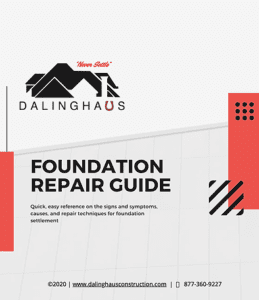Time to enter the fascinating world of Push Pier Foundation systems, get ready for an exhilarating ride! Well for us at least! lol
Push piers are a type of foundation repair system that takes on a number of names. I’ve heard them referred as piles, pin piles, push piles…..you get the point. There are a lot of names that can refer to this type of foundation repair or product. Regardless of what they are named or called out, they work….AS long as they are installed properly.
Push piers are exactly what the name represents. It is a pile system that is “pushed” into the earth by means of a hydraulic ram. As the piles are pushed into the soils, you simply add additional sections that have a slip in coupling and you are able to keep on pushing, until you hit dense soils or bedrock. Now in order for push piers to be installed correctly and effectively, you need to have a structure that has a decent load on the foundation. The hydraulic push needs to have a reaction point and that reaction point is a home or structures foundation and load on that foundation. The push pier utilizes the weight of the home push against in order to get to the dense soils below. Now this is hard to do, if you have a single story house with very little weight transferred to the foundation. You can run into problems in installing these on lighter structures, because you will start to lift the home rather than push the pipe. That is what you don’t want to have happen until you reach your target depths and load requirements. If you have a lighter loaded structure a better solution would be helical piers.
Now how deep do these push piers need to be installed? Well it all depends on the make up of your soil and terrain. Some push piers may only go 10 feet before bedrock is hit. Others can go much deeper, like 250 feet deeper. Although it is very rare to go that deep before hitting bedrock, we have had to do it. The average depth for the Southern California area is between 25-30 feet. Hillside homes can have a deeper depth requirement, just because of the amount of fill soils that were needed during grading to level out the pad to then build the home. Push piers come in 3-3.5′ sections that you continue to add until you hit your target depths and loads. So we truly can go as deep as we need to or until we run out of pipe! 😉
Now the technical mumbo jumbo. Each push pier can sustain a load of between 30,000 and 90,000 pounds depending on the size and type of push pier system. Push piers are classified by the diameter of pipe that is pushed. The 3 most common push pier pipe sizes are 2-7/8″, 3.5″, and 4.5″. Each system has a bracket system that reflects the loads that those piers will be able to hold. Heavier structures and buildings will require a larger diameter pipe. Most homes in Southern California will use the 2-7/8″ pile because it has the loading capacity to stabilize or lift your home.
Check our case study: Using Push Piers To Lift A Sinking Home In Costa Mesa, CA







